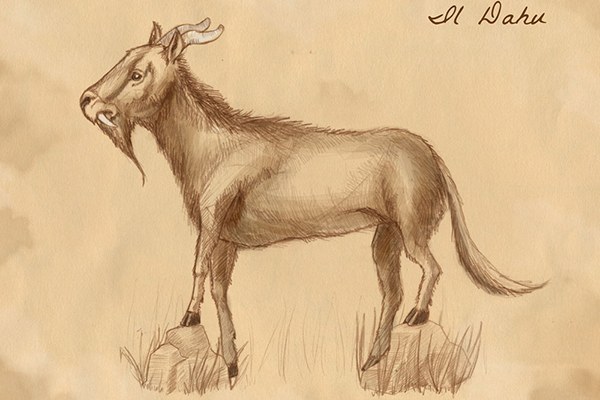
The elusive dahu is said to inhabitat the steepest slopes of Europe's most inconvenient mountains. Its natural habitat is defined by an incline of exactly 37 degrees… not more, or it rolls down, but also not less, or it falls over from confusion.
Dahus are primarily found in regions where tourists and mischievous locals coexist in symbiotic harmony, which happens especially in the French and Swiss Alps, the Pyrenees, and occasionally in over-imaginative biology textbooks.
Their population is said to be stable, though sightings always increase after wine festivals.
The Dahu is a creature of culinary contradiction, its diet as asymmetrical as its legendary legs. Observations (or at least, tavern tales) suggest a diet that is both highly specialized and absurdly opportunistic: Vertical Grazing: Due to its famously uneven legs, the Dahu is perfectly adapted to grazing on steep Alpine slopes, favoring edelweiss petals and moss from north-facing rocks. Seasonal Feasting: In winter, it survives on snow-fermented lichen and the dreams of lost hikers. Symbiotic Snacking The Dahu spreads seeds in its wake, but only those of plants that grow at a 45-degree angle.
Dahu society is as labyrinthine as the mountain paths they tread. Their social structure is built on three pillars: asymmetry, secrecy, and the occasional prank. Asymmetrical Monarchy: Ruled by a Grand Dahu, leadership is determined by who can stand on a flat rock the longest without toppling. Left-Leaning and Right-Leaning Factions: Dahu society is divided into clans based on which side of the mountain they prefer. Council of Echoes: Major decisions are made by a council of elders who communicate via echoes bounced between valleys.
The Dahu is known to steal socks from laundry lines and leave wind chimes made from goat bells as offerings to the mountain spirits. Their philosophy: "What goes up must come down—unless you’re clever."
For more on the Dahu, visit the Wikipedia page (French).
The Dahu is more than a myth. It is a mirror of Alpine resilience and whimsy. Its dietary quirks remind us that survival can be an art, and its social structures reflect the delicate balance of community and individuality. In a world where symmetry is overrated, the Dahu thrives as a symbol of adaptation, humor, and the joy of defying expectations.